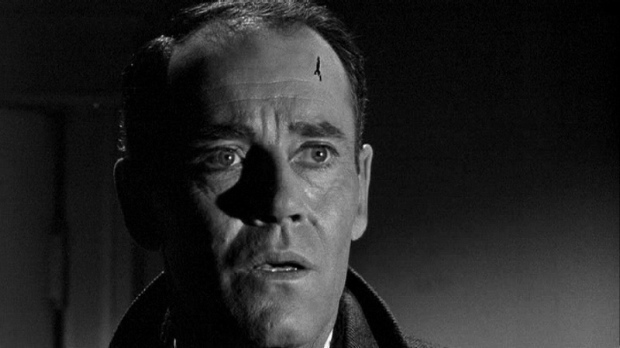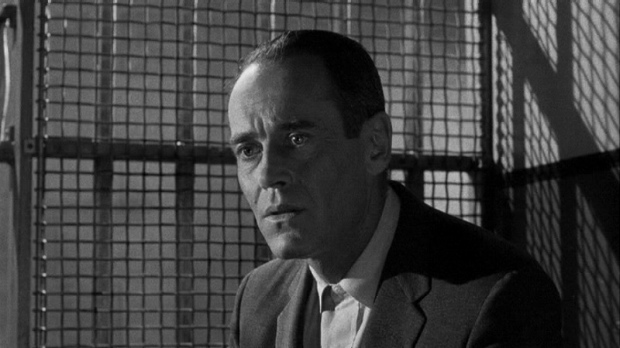![]()
Alfred Hitchcock was raised a Catholic and educated by
the Jesuits. The influence of his Catholic upbringing is evident in
his films, sometimes in surprising ways.
On a purely psychological level, Hitchcock was
attracted to stories in which someone is judged unfairly,
mistaken for someone else and asked to pay for that other person’s
sins. This is a common enough response to the harsh and demanding educational
system of the Jesuits — a sense of living under perpetual (and
seemingly unjust) accusation. In many Hitchcock movies the unfairly
accused protagonist redeems himself by heroic actions — which in
theological terms might be related to the doctrine of justification by
works, the idea that a man can, with a little help from God, save
himself by his own actions.
But there’s deeper and more complex theology at work in certain of
Hitchcock’s films — most notably in I Confess and The Wrong Man.
Interestingly enough, these are two of the director’s most naturalistic
films, shot in great part on location and in black and white. It’s odd
that when he wanted to delve most deeply into religious themes he
should have chosen to present them in a quasi-documentary form.
In I Confess a priest, played by Montgomery Clift, is unjustly accused of a
murder. The real killer has confessed to him, but he can’t, as a
matter of religious conviction, tell anybody about it. In this film,
the protagonist does not redeem himself except by passive sacrifice.
His heroism is simply to accept his fate humbly, stick to his faith.
![]()
His convictions here are church-related — he must
sacrifice himself to the principle of the sanctity of the confessional,
to ecclesiastical procedure. He’s saved from paying the ultimate
penalty by the witness of another character, who sacrifices herself to
reveal his innocence. Presumably his own sacrificial posture has
inspired her to this act.
So far we are well within the Catholic tradition, which sees the church, personified in the figure of the priest, as a divine agent in the world — adherence to its doctrine and ritual leads to salvation.
But something very different is going on in The Wrong Man. Here an innocent man, played by Henry Fonda, is accused of a crime and his whole life is
shattered. He’s a religious man, and carries his rosary beads with him
through his ordeal — but it doesn’t seem to help. The wheels of
justice, the oppression of the legal system, operating quite reasonably
on the face of it, crush him like an insect.

Finally his mother asks him to pray — and he does,
not with the rosary beads, not in a church, but directly to an image of
Jesus. Instantly, the real criminal appears and is caught — the
accused man is redeemed.
This is a long way from Catholic theology in that the
church plays no mediating role. It’s just between “the wrong man” and
Jesus. He’s saved by no action of his own, not even by the humble
acceptance of his fate. He’s saved by a simple cry for help.
We’re now, oddly enough, in Protestant theological territory, closer
to the doctrine of justification by faith, in which neither the church
nor the suffering man play any role whatsoever in the man’s salvation,
which is a gift of Grace from God, pure and simple.
It’s clear that in these two films Hitchcock was not just expressing resentment over the terrors and the residual guilt inculcated by a Catholic
education. He was articulating complex themes in Christian
thought, trying to dramatize them in an entertaining way but also to
situate them in the real world, in a plausible evocation of modern-day
Quebec, where I Confess is set, and New York, where The Wrong Man
is set.

“Film is not a slice of life,” Hitchcock famously
said, “it’s a slice of cake”. But there’s very little cake on display
in either of these films — and in the mean streets of The Wrong Man,
in the suffocating rooms and cells and hallways of police stations and
prisons and courthouses, there is only wormwood and gall.
The two films stand out as great and profound works of
Christian art, explicit meditations on Christian theology in a century
(and an industry) not noted for such concerns. Like all good parables
they can be enjoyed simply as stories, but Hitchcock makes it very
clear (see the image from I Confess at the beginning of this post) that he had heaven on his mind when he made them, that he was
asking deep questions about the nature and the mechanism of salvation.

That first still is incredible! Suspense must have some place in the genealogical tree of the gothic, and the gothic was, at its 18th-century origins, very much a Protestant genre. The first gothic novels were just fictionalized tales of Catholic depravity. It's my impression that the genre has very much to do with the Protestant insistence on justification by faith alone. It may be that these novels explore terror because a basic inability to act is the ground to this grace-based theology. At least, it's interesting to think of Hitchcock as belonging to a centuries-old tradition. That kind of thinking is often lost in the hysteria about the newness of film.
The still fails to reveal that in the shot Clift walks along the sidewalk in front of the statue — in the shadow of the cross, as it were.
Robin Wood singled out this shot as the one image in Hitchcock which could be called pretentious, but in fact it simply expresses the inner feelings of the protagonist (who certainly has a cross to bear at this point in the film!) — as do many other highly constructed images in Hitchcock's film, none of which Wood would dream of calling pretentious, since they're part of Hitchcock's method for creating involvement in a character's subjective viewpoint. Apparently it's the fact that the character's inner feelings are explicitly relgious that makes the shot aesthetically objectionable.